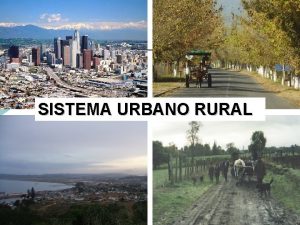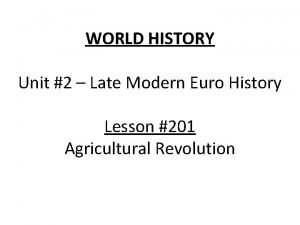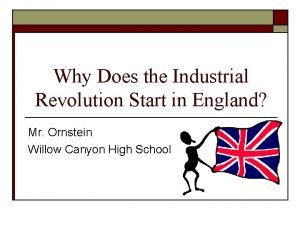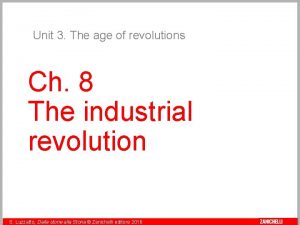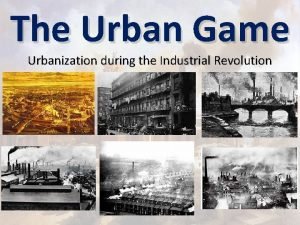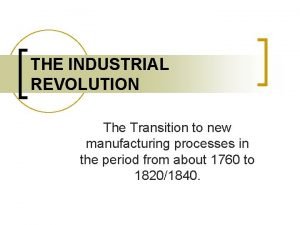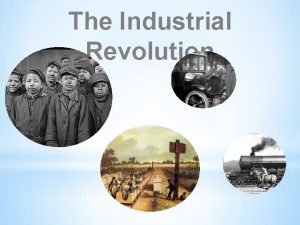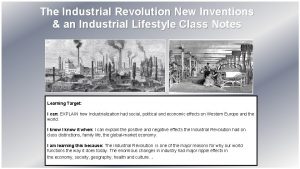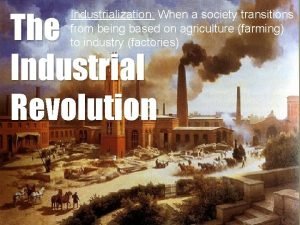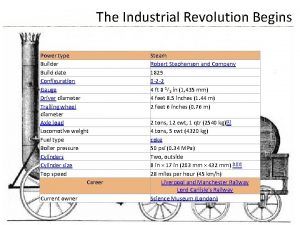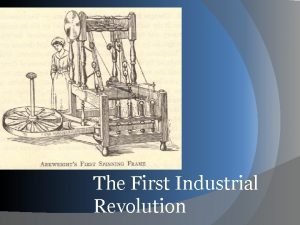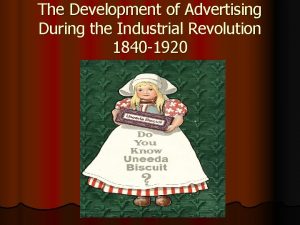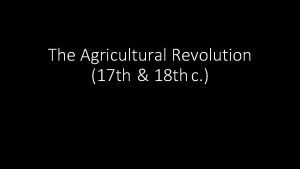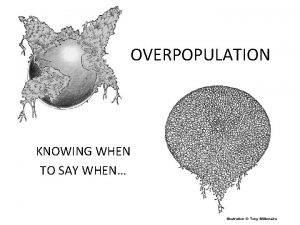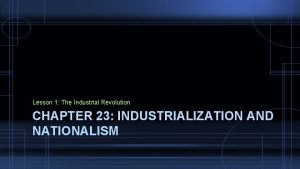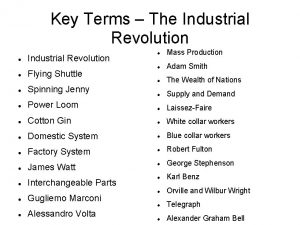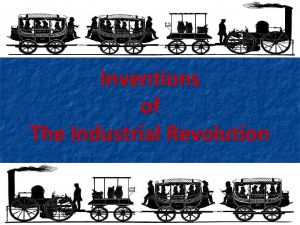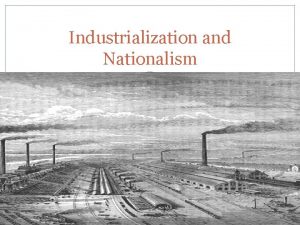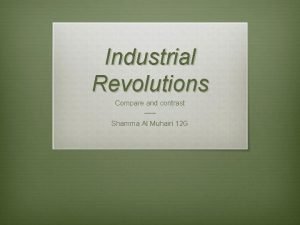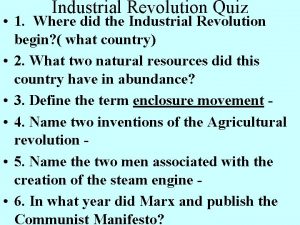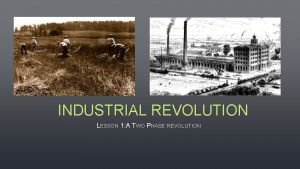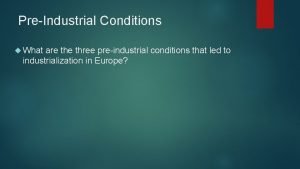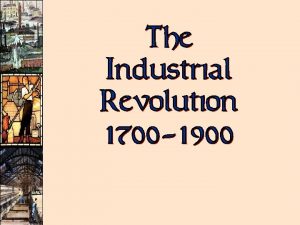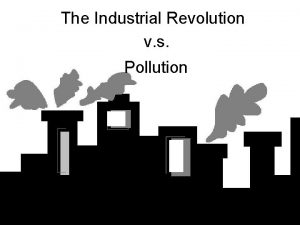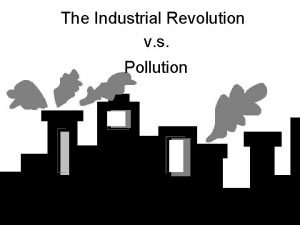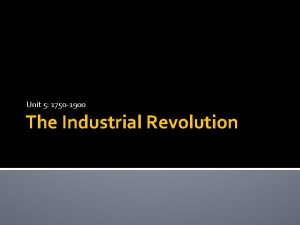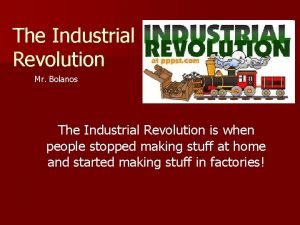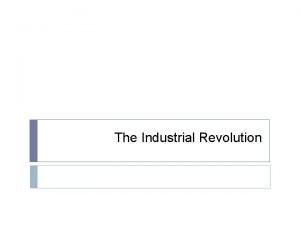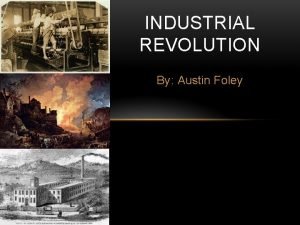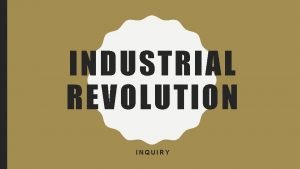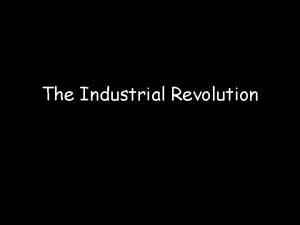INDUSTRIAL REVOLUTION From rural to industrial life Preindustrial

































- Slides: 33

INDUSTRIAL REVOLUTION From rural to industrial life

Pre-industrial society • People lived in the countryside • Their main activity was agriculture. • They worked with traditional tools and animals.

Industrial society • A lot of people left the countryside to move to cities. • The main activity was industry. • People worked in factories.

Industrial Revolution • The word economy stands for the way a country makes money. • A rural economy is an economy based in the countryside. • An urban economy is an economy based in cities and towns. • Manufacturing means making things in factories. • Commerce means buying and selling.

Industrial Revolution

Demography • Population in England increased from less than 6 millions in 1700 to more than 13 millions in 1831 • Reasons: -advances in medicine -better food

Technical inventions • Steam engines were used in new machines. • The first sector that benefited from it was textile industry.

Agricultural changes • Open-field system could not provide food for all the population. • Enclosures made it possible to apply new techniques. • New machinery used. • Bigger production

Agricultural changes • In the open-field system there were not walls around the land • Animals could enter in them when moving • Each owner had a part in each of the areas in which the territory was divided.


Agricultural changes • Enclosures made possible to cultivate in a system of rotation • It was possible to use machines. • Some peasants holding small properties sold them and tried to find a job in industries.

Agricultural changes • The rotation system made possible to get different products the same year.

Other economic changes • Mercantilism aimed at increasing exports and reduce imports • Decline of the guild system • Development of a central banking system • Common people free to go to work in cities

Colonialism • Britain’s aim was to form an empire to – Obtain raw materials for industry – Markets for British industrial production • British colonies spread in Africa and Asia mainly • British example was followed by other industrial countries

Political causes • Britain controlled the seas • Foundation of the national Bank encouraged affluent people to invest their money • Communications made trade possible

Ideological causes • Interest in printed press: – Publicize findings – Promote inventions • Literacy led to the creation of societies • New technologies were known when published • Ideas spread all over Europe

Inventions

Inventions

Inventions

Inventions

Inventions

Inventions

Industry characteristics • Before new industries appeared industrial production was made in the domestic system: – Peasants worked at home as a complement for their economies – Material owners lend them the raw materials – Owners collected the manufactures and sold them in the market

Industry characteristics • Factory system substituted the domestic system • First enterprises were familiar • Government allowed the creation of bigger companies

Industry characteristics Domestic system Factories Small-scale, so not much produced. Large-scale, so a much greater quantity of goods produced. Workers' homes were too small to hold large machines. Big enough to house machinery, which meant greater quantities could be produced. Hand power only. Big enough to house a water wheel or steam engine to power machinery. Needed a highly skilled craftsman often serving a seven-year apprenticeship, so labour was very expensive. Machines could be operated by unskilled labour such as women and children, which was much cheaper. Workmen could work when they wanted to. Employers could enforce factory discipline. No way of ensuring consistent quality. Machines all worked to the same standard. Overlookers could enforce quality control. Workers were spread over a wide area, so time wasted transporting materials from one to the other. Workers travelled to the factory in their own time, therefore, travelling was not a production cost.

Industrial changes

Main industries • Textile was the first industry in which inventions were introduced • Iron industry developed, producing the materials for other sectors such as transports • Coal was the essential product for: – Moving machines in factories – Transportation revolution

Railway • Consequences of the improvement of railways


Social changes • People moved from the countryside to the cities. • Hard working conditions. • Children work • Protest movements: – Luddities – Captain Swing – Rebecca

Political effects • Factory Act: – Aimed at improving children working conditions – Reduction of working hours • Mines Act: – Minimum age: 10 years – Restrictions to women’s work • Riots: – Due to poor people harsh condition – Asked for improvements in their salaries and working conditions

Business structure • It was impossible to control big factories with old systems • Changes: – Division of the areas to control – Control through statistics – Introduction of advertising

Ideological effects • New ideologies appeared: – Capitalism: • invest in new sectors, • laws to favour inversions – Socialism: • reaction against unregulated capitalism, • workers asked for improvements – Enlightenment: • importance given to reason, • proposals for a new society
 Describe preindustrial societies of horticulturalists.
Describe preindustrial societies of horticulturalists. Definición de espacio rural
Definición de espacio rural The idiocy of rural life
The idiocy of rural life Russian revolution vs french revolution
Russian revolution vs french revolution Did american revolution cause french revolution
Did american revolution cause french revolution The third agricultural revolution
The third agricultural revolution Enclosure movement industrial revolution
Enclosure movement industrial revolution Why did the industrial revolution start in britain
Why did the industrial revolution start in britain Industrial revolution zanichelli
Industrial revolution zanichelli The urban game us history
The urban game us history Enclosure movement industrial revolution
Enclosure movement industrial revolution Putting-out system
Putting-out system The transition to new manufacturing processes
The transition to new manufacturing processes Industrial revolution quiz
Industrial revolution quiz Industrial revolution powerpoint
Industrial revolution powerpoint Industrial revolution positive and negative effects
Industrial revolution positive and negative effects The factory
The factory Multistory building divided into crowded apartments
Multistory building divided into crowded apartments 1st industrial revolution
1st industrial revolution Industrial revolution ads
Industrial revolution ads Enclosure movement
Enclosure movement Timeline for the industrial revolution
Timeline for the industrial revolution Thomas malthus industrial revolution
Thomas malthus industrial revolution Chapter 23 lesson 1 the industrial revolution
Chapter 23 lesson 1 the industrial revolution Radio shuttle factories
Radio shuttle factories Phonograph industrial revolution
Phonograph industrial revolution Industrialization and nationalism worksheet answers
Industrialization and nationalism worksheet answers First and second industrial revolution
First and second industrial revolution Industrial revolution vocabulary
Industrial revolution vocabulary Entrepreneurs industrial revolution
Entrepreneurs industrial revolution Consequences of industrial revolution
Consequences of industrial revolution Quiz 1: development of industrial revolution
Quiz 1: development of industrial revolution Lesson 1 the industrial revolution
Lesson 1 the industrial revolution Industrial revolution jeopardy
Industrial revolution jeopardy

